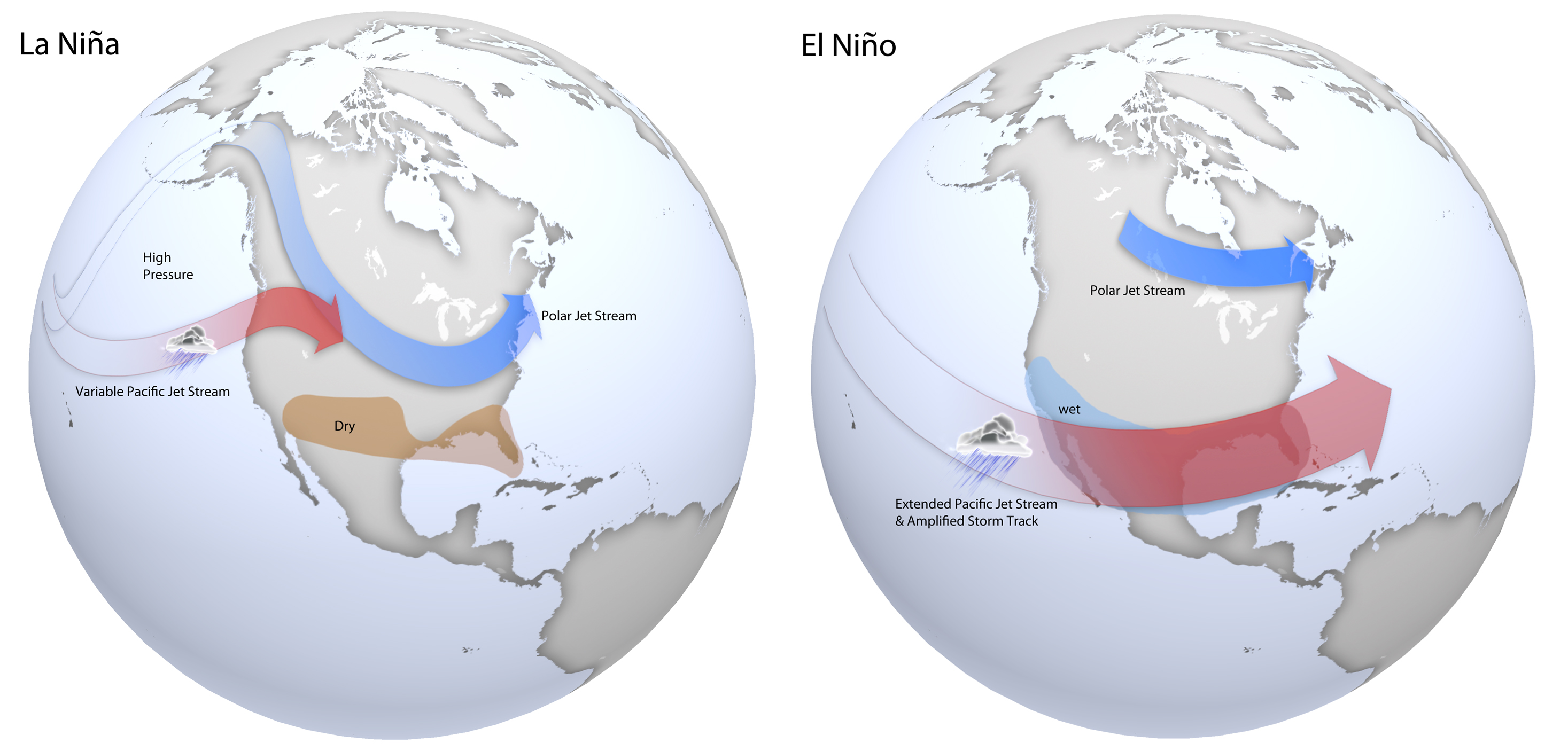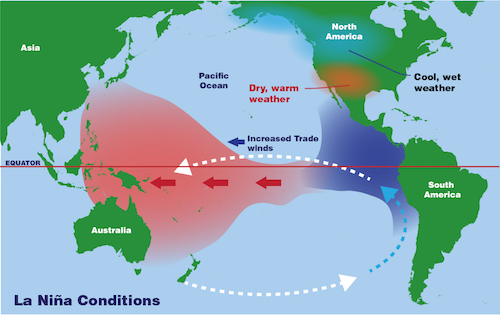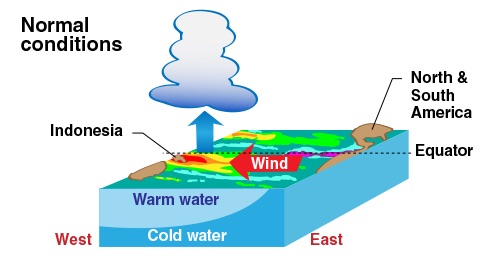El Nino Y La Nina Phenomenon
It represents the cold phase of the ENSO cycle. Scientists call these phenomena the El Niño-Southern Oscillation ENSO cycle.

El Nino And La Nina Information
It represents the warm phase of the ENSO cycle.

El nino y la nina phenomenon. It is a climatic phenomenon product of the interaction of the hydrosphere and the atmosphere that causes serious imbalances. Episodes of El Niño and La Niña typically last nine to 12 months but can sometimes last for years. They influence both temperature and rainfall.
El Niño conditions occur when abnormally warm waters. For example they unpredictably create. La Niña causes water in the eastern Pacific to be colder than usual.
Normally strong trade winds blow from the east along the equator pushing warm water into the western Pacific Ocean. El Niño and La Niña are considered the ocean part of ENSO while the Southern Oscillation is its atmospheric changes. The phenomenon of El Niño and subsequently La Niña The Boy and The Girl currently known as El Niño Oscilación Sur ENOS El Niño Southern Oscillation is a recurring hydro-meteorological event that appears in an irregular manner every 2 to 7 years.
El Fenómeno de el Niño es un evento climático que se genera. La Niña refers to the periodic cooling of sea-surface temperatures across the east-central equatorial Pacific. Coupled Because ENSO involves interaction between the ocean and the atmosphere both of which play a role in reinforcing changes in each other it is known as a coupled oceanatmosphere phenomenon.
El Niño refers to the above-average sea-surface temperatures that periodically develop across the east-central equatorial Pacific. The El Niño La Niña phenomena are the main sources of year-to-year variability in weather and climate for many areas of the world. El Niño is a natural phenomenon experienced in the equatorial Pacific which causes temporary alterations in the world climate.
El Niño La Niña El Niño and La Niña change worldwide weather patterns in complex ways. Then La Niña is the cooling phase. In the 1980s when the opposite phase of El Niño was discovered ie cooler-than-normal ocean temperatures scientists called it La Niña Spanish for little girl.
El Niño and La Niña are the warm and cool phases of a recurring climate pattern across the tropical Pacificthe El Niño-Southern Oscillation or ENSO for short. El Niño and La Niña can both have global impacts on weather wildfires ecosystems and economies. It is normally characterized by complex and abnormally warm ocean temperatures in the Pacific Ocean in the area near the equator which results in global weather events and sea-surface temperature changes.
Each El Niño or La Niña event lasts between 912 months and on average. While focused on a small section of the Pacific near the Equator these shifts have global ramifications. Like many siblings the two weather patterns are opposites in almost every way.
ENSO - an interaction with the atmosphere and the ocean These episodes alternate in an irregular inter-annual cycle called the ENSO cycle. El Nino is the warm phase of a larger phenomenon called the El Nino-Southern Oscillation ENSO. El Niño and La Niña are the extreme phases of the ENSO cycle.
In the same region El Niño can cause the water to be warmer than usual. They nicknamed the phenomenon El Niño Spanish for little boy in connection with the celebration of the Christian holiday marking the birth of Jesus. El Niño is a Spanish term meaning little boy while La Niña is also a Spanish term meaning little girl El Niño is associated with warmer water in the Pacific Ocean along the equator while La Niña is associated with colder than usual water temperatures in the Central and Eastern Pacific Ocean.
El Niño and La Niña are two opposing climate patterns that break these normal conditions. El Niño is the warming phase of the waters in the eastern Pacific off the coast of South America. Both phenomena disrupt weather and temperature around the globe.
In Spanish El Niño means the little boy and La Niña means the little girl They are sort of like a brother and sister. They called this phenomenon the El Niño current in allusion to the arrival of Baby Jesus. The terms El Niño and La Niña refer to periodic changes in Pacific Ocean sea surface temperatures 1 that have impacts on weather all over the globe.
El Niño and La Niña are a global climate phenomenon caused by cyclical shifts in the water temperature of the Pacific Ocean. The strongest natural fluctuation of climate on interannual time-scales is the El Niño-Southern Oscillation ENSO phenomenon and ENSO-like fluctuations also dominate decadal time-scales sometimes referred to as the Pacific decadal oscillation. The transition between El Niño and La Niña tends to be more rapid than the transition from.
The El Niño phenomenon is an exceptional increase in the temperature of the waters of the central and eastern Pacific Ocean off the Peruvian coast. An El Niño or La Niña event lasts 1 to 2 years and occurs every 3 to 6. The pattern shifts back and forth irregularly every two to seven years and each phase triggers predictable disruptions of temperature precipitation.
Scientists do not yet understand what triggers these events. La Nina the cool phase of ENSO is a pattern that describes the unusual cooling of the regions surface waters. Between these two phases is a third phase called ENSO-neutral.
74 rows The Oceanic Ni ñ o Index ONI has become the de-facto standard that NOAA uses for. El Niño and La Niña tend to alternate in an irregular cycle which is often referred to as the ENSO cycle. In the Pacific Ocean near the equator temperatures in the surface ocean are normally very warm in the western Pacific and cool in the eastern Pacific 2This helps to generate heavy rains over southeastern Asia and.
Son las componentes oceánicas del ENOS Oscilación del Sur que corresponde a la aparición de tiempo en tiempo de aguas superficiales relativamente más cálidas El Niño o más frías La Niña que lo normal en el Pacífico tropical central y oriental frente a las costas del norte de Perú Ecuador y sur de Colombia. ENSO El Nino La Nina and NAO. ENSO stands for El Niño Southern Oscillation where Southern Oscillation is the term for atmospheric pressure changes between the east and west tropical Pacific that accompany both El Niño and La Niña episodes in the ocean.
La Niña translates as girl-child and is the opposite ENSO phase to El Niño. ENSO originates in the tropical Pacific but affects climate.

What Is La Nina Nasa Space Place Nasa Science For Kids

What Is La Nina Nasa Space Place Nasa Science For Kids

Posting Komentar untuk "El Nino Y La Nina Phenomenon"